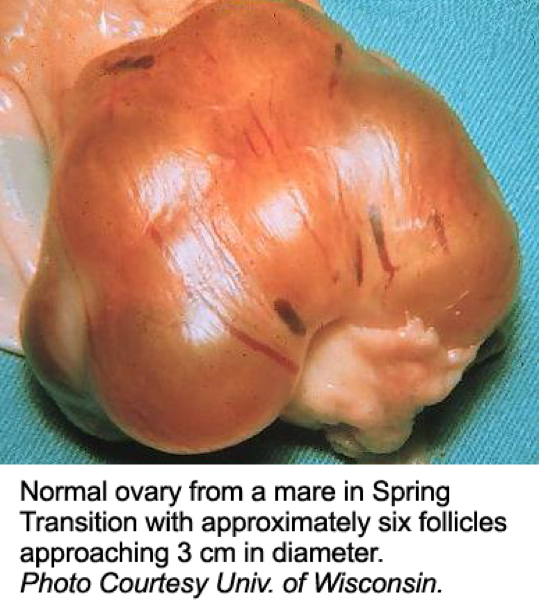Mare Follicle Size During Ovulation

During the fetal development of the mare itself, a pool of primordial follicles forms as ovarian tissue, and each follicle consists of prophase I oocytes surrounded with a single layer of flattened granulosa cells.1 By the time the mare reaches sexual maturity, her ovaries contain thousands of follicles, but usually only one begins to develop during each estrous cycle. Until recently, exactly how only one follicle per wave becomes dominant while the remaining follicles undergo atresia is not entirely clear, but the deviation in growth between the two largest follicles occurs soon after FSH levels decrease.2 As a dominant follicle forms, it produces inhibin and suppresses the growth of other follicles in the ovaries.
The ovary is a bean shaped organ which varies in size with season. During the winter, most mares have small, hard ovaries. As the light increases, there is an increase in connective tissue and small follicles and the ovary increases in size. The ovaries and follicles of the mare are the largest in the farm animal species [2-3 inches (6-8 cm) in length, 1-1.5 inches (3-4 cm) in height, 70-80 gm]. The ovary has both an exocrine function (produces eggs) and an endocrine function (produced hormones).3
Factors Determining Follicle Size in Mares
In mares, follicles typically ovulate at diameters of between 35 and 55 mm. Within the context of a breeding program, it is important to establish baselines for the ongoing measurement of mares' follicles, as well as continuity in determining related measurements. By Day 16 of the mare's cycle, the developing follicle has reached the size at which it secretes enough hormone to bring on the external characteristics of heat.

There are several factors that determine the size equine follicles will ultimately attain prior to ovulation. Among these are general health, stage of life, diet, temperament and the presence of existing medical conditions. Then, there is the delicate hormonal interplay which occurs during the estrous cycle.
Typically, preovulatory follicle grow at a rate of 3 mm a day for up to 2 days before ovulation. The size then remains constant, before diminishing by 2-3 mm during the last 12 hours.4
It has been suggested that the follicle destined to be a dominant follicle is the first to reach a critical follicle size of 21-23 mm prior to other follicles and thus creating a condition that inhibit the further growth of the subordinate follicle (Gastal et al., 1997). Several hormones have been demonstrated as potential factors that control the follicle growth and subordination. During a 21-22 day of oestrous cycle, the gonadotropin releasing hormone (GnRH) releases substantially from the hypothalamus and subsequently stimulates the production of the two important gonadotropins (follicle stimulating hormone (FSH) and luteinizing hormone (LH)). FSH plays a key role in the emergence of the ovulatory wave, but the plasma circulating FSH declines when the size of the largest follicle reaches approximately 13 mm. It seems likely that the largest follicle have ability to utilize the low level of FSH, while other factors such as LH, inhibin, insulin-like growth factor 1 (IGF-1) and estradiol also play a role during follicle deviation.1

Determination of Follicle Presence and Size
After ovulation, the cells that remain in the follicle divide and begin to produce progesterone. The ovulated follicle forms the corpus luteum (CL). The CL produces progesterone for 14-15 days. If the mare is not pregnant, the CL regresses and stops producing progesterone.3
For mares, rectal palpation by a veterinarian provides critical information regarding the condition of the reproductive tract, and can confirm the presence of a follicle. Further testing, including uterine ultrasound, uterine biopsy, and cultures may be recommended. Finally, the conformation of the vulva should be periodically evaluated to determine if the mare is susceptible to uterine infections, which become more likely as the mare ages.
Equine Breeding Products
You can find equine breeding products in our online store. Login to your account to view prices and purchase or create an account. Please note you must have a valid veterinarian license to create an account. If you do not, please forward our information to your veterinarian.
1Tharasanit, T. Control of Follicle Development and Ovulation in Mare: Principal and
Clinical Aspects. Thai J Vet Med Suppl. 2011. 41: 55-57.
2Gastal, E.L., Gastal, M.O., Bergfelt, D.R. and Ginther, O.J. 1997. Role of diameter differences among follicles in selection of a future dominant follicle in mares. Biol Reprod. 57: 1320-1327.
3wisc.edu.
4Koskinen E, Kuntsi H, Lindeberg H, Katila T. Predicting ovulation in the mare on the basis of follicular growth and serum oestrone sulphate and progesterone levels. US National Library of Medicine National Institutes of Health, 1989 Apr;36(4):299-304.
About NexGen Pharmaceuticals
NexGen Pharmaceuticals is an industry-leading veterinary compounding pharmacy, offering sterile and non-sterile compounding services nationwide. Unlike other veterinary compounding pharmacies, NexGen focuses on drugs that are difficult to find or are no longer available due to manufacturer discontinuance or have yet to be offered commercially for veterinary applications, but which still serve a critical need for our customers. We also specialize in wildlife pharmaceuticals, including sedatives and their antagonists, offering many unique options to serve a wide array of zoo animal and wildlife immobilization and anesthesia requirements.
Our pharmacists are also encouraged to develop strong working relationships with our veterinarians in order to better care for veterinary patients. Such relationships foster an ever-increasing knowledge base upon which pharmacists and veterinarians can draw, making both significantly more effective in their professional roles.




